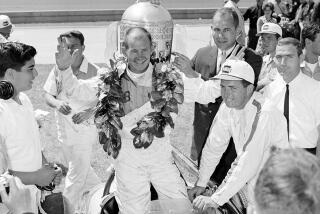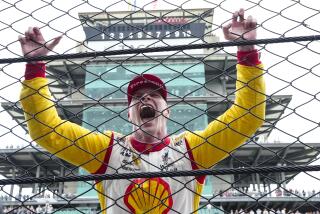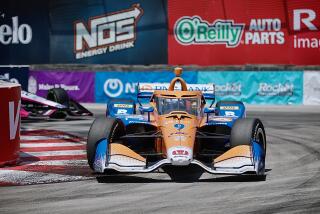Voters Can’t Pass Up Andretti Victory
There have been 43 Formula One races in the United States--not counting the 11 times the Indianapolis 500 was an F1 points race--and in the consensus of race writers and historians, Mario Andretti’s dramatic win at Long Beach in 1977 was the most memorable.
Andretti passed South Africa’s Jody Scheckter on the next-to-last lap of the course, which ran along Ocean Blvd. before dropping down on the flatland where it now runs. It was the first pass in two years of Grand Prix racing at Long Beach and when Andretti slipped past Scheckter’s Ferrari, the crowd awoke with a wild cheer that echoed off the Queen Mary.
For the record:
12:00 a.m. Sept. 29, 2000 For the Record
Los Angeles Times Friday September 29, 2000 Home Edition Sports Part D Page 11 Sports Desk 1 inches; 22 words Type of Material: Correction
Auto racing--In Formula One, Michael Andretti drove for McLaren in 1993 and Jody Scheckter drove for Wolf in 1977. The teams were incorrect in a story last week.
“Winning the Grand Prix of my country is more gratifying even than winning the Indy 500,” said Andretti, who only a few years before had become a naturalized citizen. That race remains the only U.S. Grand Prix won by an American driver.
The 1977 race received more than twice as many votes as any of the other 14 nominated for consideration.
The other top vote getters were Bruce McLaren’s win at Sebring, Fla., in 1959 in the first USGP, when he was the youngest F1 winner, and Nigel Mansell’s valiant, though against-the-rules attempt to push his car across the line after crashing in the final corner at Dallas in 1984.
Curiously, that same Dallas race was named “the worst U.S. Grand Prix” by On Track magazine, a choice supported by the British weekly Autosport, which blamed it for:
“All the unwelcome things [that F1] has become used to since, . . . concrete walls and debris fencing, lack of runoff, bumps and undulations, blind corners with dubious marshaling, inadequate means of removing damaged cars. Forget about the race fan, it is a media event. An ultra-Mickey Mouse parking lot track.”
About the only happy person there in the 100-plus degree weather was winner Keke Rosberg.
One write-in vote by a journalist was cast for Sunday’s U.S. Grand Prix, citing the historical significance of the Indianapolis Motor Speedway, the enthusiasm of a sellout crowd of more than 200,000, and the fact that the race marks the return of F1 to the U.S. after an absence of nine years.
*
Formula One cars were not allowed on the track Thursday in Indianapolis, but that didn’t keep the drivers from studying the 2.606-mile course by motor scooter, passenger car, pace car, bicycle, and on foot in anticipation of today’s first round of practice for Sunday’s race.
Mika Hakkinen, the defending champion and points leader from Finland, both walked and rode.
“I think it better to do both, to go around with the car and go by foot,” he said. “You need to do both to look at the curves and understand the characteristics of the corners. And because part of the circuit is banked, it is so important to understand how deep it is and if you can really use special lines in some places. You also must understand if the circuit is bumpy or not. That’s why it is better to do it by foot and by car.”
Michael Schumacher, the German two-time champion who trails Hakkinen by only two points, seemed less concerned with a close look, although he rode a scooter around the track at a leisurely pace.
“We’re all professionals and we’ve been around long enough to understand the circuit quick enough,” the slender Schumacher said. “And we have simulations to somehow give us a rough direction how to get the car working, then to optimize it.
“So it might be a little bit more difficult [than other circuits] but not as much as what people think.”
Listening to Schumacher, Hakkinen just shook his head before continuing his discussion of the new track.
“A Formula One car is so quick, to really learn it, it is very, very difficult,” he said.
The discussion ends today when the 22 F1 machines take to the track, running in the opposite direction used by Indy cars and Winston Cup stock cars.
Whatever Hakkinen and Schumacher feel, it should be quite a sight, watching nimble 800 horsepower machines careening through 13 turns inside the famed Indy 500 oval.
*
Formula One may have no American drivers and no American teams, but it does have one prominent racing engineer.
Mike Wilson, 37, grew up in Los Angeles with an abiding goal to become part of the Formula One scene. In 1994 he worked with Dan Gurney in testing the first Toyota Indy car engine, and from that experience he moved to Europe and worked with LeMans and touring cars before filling an opening with the Sauber team.
“From Sauber I moved to BMW last year and with my previous experience with Dan and the others, I got a position as an engine engineer and now I am working with BMW and Jenson Button,” said Wilson, who lives in Munich. “I think I am one of only two Americans in all of Formula One.
“My first responsibility on the weekend is to work very closely with Jenson and his chassis engineers and try to tune the engine performance characteristics to the particular circuit. So I do quite a bit of work on the mapping side to try to make the engine more driveable and easier for Jenson to handle.”
From mapping out the characteristics of the Indianapolis track, Wilson believes cars will be reaching the highest speed of any Formula One circuit.
“We’ve definitely figured they are going to be as high, or higher, than we reach at Monza or Hockenheim,” he said. “That would be about 220 mph. The circuit is a pretty interesting compromise. There is so much simulation we can achieve an equivalent lap time in one of two downforce configurations. If we take the downforce off and just run the straightaway very quickly, then we lose a little bit on the infield.
“Or we can add more downforce and lose time on the straightaway and make the time up in the infield. There are a couple of ways for us to go with setting the car up here.”
Wilson has been at Indianapolis before, testing with Gurney’s Indy car team.
“As a kid growing up, I always had a vision in my head: I would be standing on race day, May 30, looking at Jim Nabors [singing ‘Back Home Again in Indiana.’] It was always something really special for me.”
There’ll be no Jim Nabors on Sunday, but Wilson’s dual dream of working with Formula One and being at Indianapolis for a big race will come true.
PERRIS SPRINT CARS
Veteran Mike Kirby, who won the California Racing Assn. sprint car championship in 1993, the last year of its existence, is kicking up a storm in the CRA’s replacement, the Sprint Car Racing Assn.
Kirby won races on successive nights at Ventura Raceway and Perris Auto Speedway three weeks ago and, after taking a week off to go fishing, will be back Saturday night at Perris. And when the 36-year-old from Lomita isn’t in a sprint car, he’s busy racing--and sometimes winning--Figure 8s at Ventura and Perris.
Perris will announce next week a $25,000-to-win purse for its Oval Nationals, Nov. 10-11. It will be a record purse for a non-winged sprint car race.
ACCORDIONS AND TQS TOO
Bring an accordion, get in free at Saturday night’s NASCAR super stock show at Irwindale Speedway.
“This is just our way of having some fun and promoting a little bit of musical diversity,” said track official Pat Patterson.
Also on the program will be a 20-lap feature for U.S. Auto Club TQ midgets on the infield third-mile oval. Drivers J.J. Ercse, Walt Johnson and Greg Edenholm are separated by only 32 points.
Rosie Rosenlof, self-styled “TQ historian,” writes to note that Jay Drake, who has a near-record 17 USAC wins this year in Silver Bullet, sprint car and midgets, is a TQ graduate--and that Jay’s father, Mike, was TQ rookie of the year, and a two-time champion and former president of the National Midget Racing Assn. TQs.
Drake, of Val Verde, needs three more wins this year to break the record of 19 set by A.J. Foyt in 1961 and equaled by Sleepy Tripp in 1988.
LAST LAPS
Wally Parks, founder of the National Hot Rod Assn., will be one of seven inductees into the Automotive Hall of Fame in Dearborn, Mich., on Oct. 17. Being inducted posthumously are race car builders Enzo Ferrari and Ettore Bugatti, and Alice Huyler Ramsey, in 1909 the first woman to drive across the United States.
Sears Point Raceway began a $35-million modernization program this week, designed to make the Northern California facility “one of the premier motor racing venues in the world.” The two-year project includes the building of 64,000 hillside terrace seats.
(BEGIN TEXT OF INFOBOX / INFOGRAPHIC)
This Week’s Races
NASCAR WINSTON CUP, MBNA.com 400
* When: Today, first-round qualifying, 10:30 a.m.; Saturday, second-round qualifying, 8:30 a.m.; Sunday, race (TNN, 9:30 a.m.)
* Where: Track: Dover Downs International Speedway (oval, 1-mile, 24 degrees banking in turns), Dover, Del.
* Race distance: 400 miles, 400 laps.
* Defending champion: Mark Martin.
* Next race: NAPA AutoCare 500, Oct. 1, Martinsville, Va.
* On the net: https://www.nascar.com
BUSCH GRAND NATIONAL, MBNA.com 200
* When: Today, qualifying, 9:15 a.m.; Saturday, race (TNN, 10 a.m.)
* Where: Dover Downs International Speedway (oval, 1-mile, 24 degrees banking in turns), Dover, Del.
* Race distance: 200 miles, 200 laps.
* Defending champion: Dale Earnhardt Jr.
* Next race: All Pro Bumper to Bumper 300, Oct. 7, Concord, N.C.
* On the net: https://www.nascar.com
CRAFTSMAN TRUCKS, MBNA e-commerce.com 200 200
* When: Today, race 1:15 p.m. (ESPN, 5 p.m., tape).
* Where: Dover Downs International Speedway (oval, 1-mile, 24 degrees banking in turns), Dover, Del.
* Race distance: 200 miles, 200 laps.
* Last year: Inaugural event.
* Next race: O’Reilly 300, Oct. 13, Fort Worth, Texas.
* On the net: https://www.nascar.com
FORMULA ONE, United States Grand Prix
* When: Saturday, qualifying (Fox Sports Net, 11 a.m.); Sunday, race (Fox Sports Net, 11 a.m.)
* Where: Indianapolis Motor Speedway (road course, 2.606-miles, 13 turns), Indianapolis.
* Race distance: 190.294 miles, 73 laps.
* Last year: Inaugural race.
* Next race: Japanese Grand Prix, Oct. 8, Suzuka.
* On the net: https://www.f1.on.net
More to Read
Go beyond the scoreboard
Get the latest on L.A.'s teams in the daily Sports Report newsletter.
You may occasionally receive promotional content from the Los Angeles Times.










